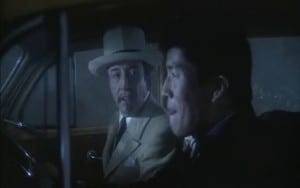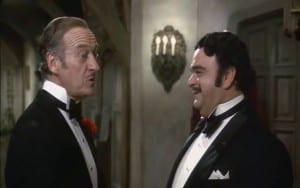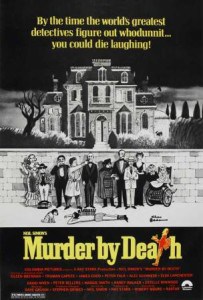“You are cordially invited to dinner . . . and a murder!”
The late 1970s and early ’80s experienced yet another revival of the murder mystery spoof. There were films like 1974’s heavily British, stylish but overly long Murder on the Orient Express and, four years later, its direct follow-up, the even longer, less successful Death on the Nile. Both movies, every role filled by a big-name star, contained the illusion of seriousness but coated with a dash of fluff that informed the audience rather early on that they weren’t to take the proceedings too seriously.
Putting aside the films of this period that were in the slasher or bloodbath genre, the likes of Class Reunion and the terrible Psycho revisits with Anthony Perkins, there are also movies of the drawing room variety. Most of these, and others, make no pretense at seriousness, some becoming out-and-out slapstick.
Especially intriguing is the spooky old house genre, whose prototype has to be, aptly titled, The Old Dark House (1932), with such big stars of that day as [intlink id=”299″ type=”category”]Boris Karloff[/intlink], Charles Laughton, Melvyn Douglas, Gloria Stuart, Raymond Massey and Ernest Thesiger. Later versions of this theme include Haunted Honeymoon, House of Long Shadows, The Spiral Staircase (1975), Clue and the often-filmed The Cat and the Canary.
Two films of this time, both scripted by Neil Simon, specifically spoof not only the haunted house movies in Murder by Death but the private detective capers in The Cheap Detective, which grew out of the success of the first. The Cheap Detective spoofed Humphrey Bogart movies and carried over some stars from the first film—Peter Falk, Eileen Brennan, James Coco and James Cromwell. The idea that had begun with Murder on the Orient Express, that of the all-star cast, was continued in both Simon films.
Murder by Death avoids for the most part slapstick, which might have helped it in its weaker moments. It incorporates—and exaggerates—all the haunted house clichés and requests that the audience suspend credibility in this gathering, in one place, of many of the most famous fictional detectives and their sidekicks, with slightly changed names. Not so unrealistic an idea after all, as these sleuths were created at the height of the detective genre, the ’20s and ’30s, by the likes of Agatha Christie, Dashiell Hammett and Earl Derr Biggers.
 The obvious exclusions are Sherlock Holmes and Doctor Watson, who, actually, would have needed a time warp to have joined the others, as Sir Arthur Conan Doyle’s characters were active at the turn of the twentieth century. (In fact, ending up on the proverbial cutting room floor was a scene from the end of Murder by Death when the famous pair are met en route to the mansion, too late to participate in the shenanigans.)
The obvious exclusions are Sherlock Holmes and Doctor Watson, who, actually, would have needed a time warp to have joined the others, as Sir Arthur Conan Doyle’s characters were active at the turn of the twentieth century. (In fact, ending up on the proverbial cutting room floor was a scene from the end of Murder by Death when the famous pair are met en route to the mansion, too late to participate in the shenanigans.)
To begin the story—— Lionel Twain (Truman Capote) invites five detectives to a dinner . . . and a murder . . . at his dark old mansion, at 22 Twain. He is “aided,” if that’s the right word, by his blind butler Jamesir Bensonmum ([intlink id=”273″ type=”category”]Alec Guinness[/intlink]), who applies the Eisenhower stamps, not to the envelopes, but to Twain’s desk top, securing each with a blow of his fist. One wonders how the recipients ever got their invitations, or ever showed up! But, hey, we’re not dealing with reality here! Hasn’t the audience already been asked to suspend its belief?
 Anyway, four of the detectives and their associates are traveling through the fog in their cars. The first pair are a couple actually, Dick and Dora Charleston ([intlink id=”55″ type=”category”]David Niven[/intlink] and Maggie Smith), stand-ins for Hammett’s Nick and Nora Charles, who, lost, have stopped to make a phone call for directions. Here occurs the first of some weak jokes, not always a good sign so early in any movie. “Sounded as though somebody snipped the wire,” he says. “Really? What did it sound like?” she asks. “Snip,” he replies.
Anyway, four of the detectives and their associates are traveling through the fog in their cars. The first pair are a couple actually, Dick and Dora Charleston ([intlink id=”55″ type=”category”]David Niven[/intlink] and Maggie Smith), stand-ins for Hammett’s Nick and Nora Charles, who, lost, have stopped to make a phone call for directions. Here occurs the first of some weak jokes, not always a good sign so early in any movie. “Sounded as though somebody snipped the wire,” he says. “Really? What did it sound like?” she asks. “Snip,” he replies.
